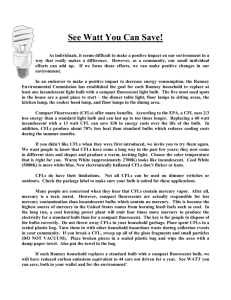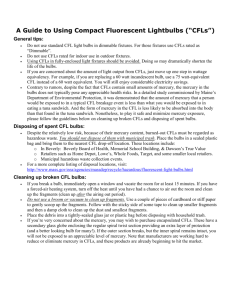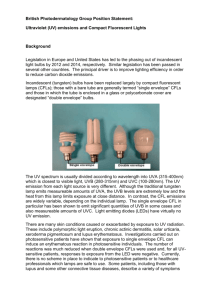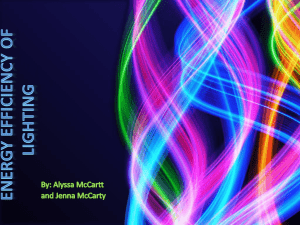Compact Fluorescent Lamps
advertisement
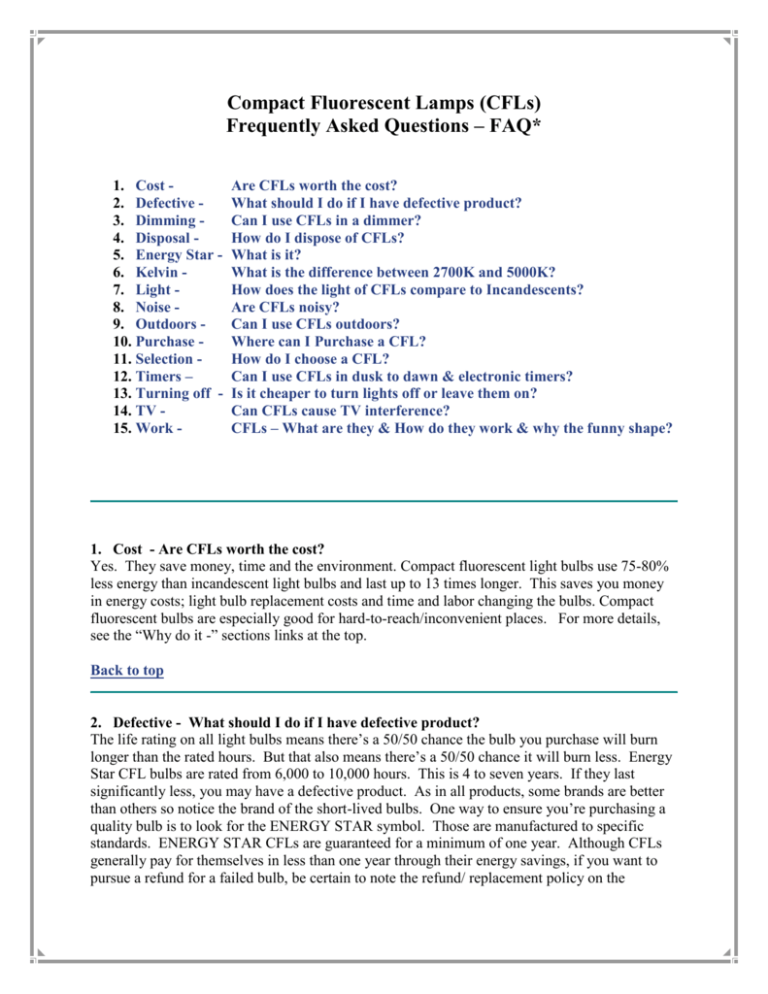
Compact Fluorescent Lamps (CFLs) Frequently Asked Questions – FAQ* 1. Cost 2. Defective 3. Dimming 4. Disposal 5. Energy Star 6. Kelvin 7. Light 8. Noise 9. Outdoors 10. Purchase 11. Selection 12. Timers – 13. Turning off 14. TV 15. Work - Are CFLs worth the cost? What should I do if I have defective product? Can I use CFLs in a dimmer? How do I dispose of CFLs? What is it? What is the difference between 2700K and 5000K? How does the light of CFLs compare to Incandescents? Are CFLs noisy? Can I use CFLs outdoors? Where can I Purchase a CFL? How do I choose a CFL? Can I use CFLs in dusk to dawn & electronic timers? Is it cheaper to turn lights off or leave them on? Can CFLs cause TV interference? CFLs – What are they & How do they work & why the funny shape? 1. Cost - Are CFLs worth the cost? Yes. They save money, time and the environment. Compact fluorescent light bulbs use 75-80% less energy than incandescent light bulbs and last up to 13 times longer. This saves you money in energy costs; light bulb replacement costs and time and labor changing the bulbs. Compact fluorescent bulbs are especially good for hard-to-reach/inconvenient places. For more details, see the “Why do it -” sections links at the top. Back to top 2. Defective - What should I do if I have defective product? The life rating on all light bulbs means there’s a 50/50 chance the bulb you purchase will burn longer than the rated hours. But that also means there’s a 50/50 chance it will burn less. Energy Star CFL bulbs are rated from 6,000 to 10,000 hours. This is 4 to seven years. If they last significantly less, you may have a defective product. As in all products, some brands are better than others so notice the brand of the short-lived bulbs. One way to ensure you’re purchasing a quality bulb is to look for the ENERGY STAR symbol. Those are manufactured to specific standards. ENERGY STAR CFLs are guaranteed for a minimum of one year. Although CFLs generally pay for themselves in less than one year through their energy savings, if you want to pursue a refund for a failed bulb, be certain to note the refund/ replacement policy on the package and keep the purchase receipt. CFLs should last 5 years or more but there are some applications that will shorten their life. See: When to use CFLs? Back to top 3. Dimming - Can I use CFLs in a dimmer? Yes & No – There are CFLs specifically designed to be dimmed. If you purchase one of those, yes. However, generally speaking, CFL light bulbs cannot be dimmed. Back to top Back to When to use CFLs? 4. Disposal - How do I dispose of CFLs? CFLs contain mercury. Mercury is used in many household items: thermostats, thermometers, fluorescent lights, batteries and switches for appliances, lights and automobiles. An extremely small amount of mercury—an average of four milligrams—is sealed within the CFL. It is an essential, irreplaceable element in CFLs and fluorescent lights. For a basis of comparison, there are about one to three grams of mercury in your average home thermometer. It would take between 250 to 1000 CFLs to equal that same amount. If your ENERGY STAR®-qualified bulb fails within its one year warranty period, return it to the place of purchase for a replacement bulb. You could also fill out a CFL failure card (available at many retail locations) to help track lamp performance. If your bulb breaks, your greatest risk actually is being cut by broken glass. Handle it sensibly and be certain to sweep up all the glass fragments (don’t vacuum, that can disperse particles). Place the broken pieces in a plastic bag and wipe the area with a damp paper towel to pick up any shards of glass or powder. The amount of mercury will be about the size of the period at the end of this sentence. For more information, see the EPA’s Fact Sheet on mercury in CFLs. Never incinerate CFLs (or any other mercury-containing product for that matter). Households: CFL disposal from households: Some communities offer household hazardous waste days or recycling programs that accept CFLs. Check with your local or municipal government entity responsible for solid waste or your county health department. Household hazardous waste collection is preferred but you can lawfully dispose of CFLs in your household garbage. Of course there may be local ordinance or landfill requirements. To reduce the risk of bulb breakage or contamination and to protect yourself and garbage staff from cuts, wrap the bulb in a sealed plastic bag and discard it with your trash. Businesses: For CFL disposal from businesses: It is recommended all CFLs be recycled if possible. See the DEQ Electric Lamp publication for a summary of business requirements. Back to top 2 5. ENERGY STAR® - What is it? The ENERGY STAR® label on products stands for superior energy performance. ENERGY STAR was introduced in 1992 as a voluntary labeling program to identify and promote energy efficient products that reduce carbon dioxide emissions. ENERGY STAR products prevent greenhouse gases by meeting strict energy efficiency guidelines set by the US Environmental Protection Agency and Department of Energy. The ENERGY STAR label doesn’t stop at light bulbs or qualified light fixtures. There are more than 35 product categories rated by ENERGY STAR®, including energy efficient homes. Visit www.energystar.gov or call 1-888-STARYES (1-888-782-7937) to learn more. Back to top 6. Kelvin - What is the difference between 2700K and 5000K? The K stands for Kelvin. The Kelvin temperature of a lamp refers to the actual color of the light and is a comparison to natural outdoor light. A 2700K lamp has a warmer tone than a 5000K lamp. An incandescent lamp is 2700K, a warm white fluorescent lamp is 3000K, a cool white fluorescent lamp is 4100K and noon, outdoor sunlight is about 6000K. The 2700K matches the warm soft light color of candlelight, firelight or an ordinary incandescent bulb. The 5000K lamp produces a much whiter light more closely associated with sun light. The advantage of this 5000K light color is that it increases contrast. Black becomes blacker, white become whiter. Printed material (black type on white paper) is easier to read under 5000K light. Therefore, this lamp makes an excellent reading light and can help reduce eye fatigue. Back to top Back to When to use CFLs? 7. Light - How does the light of CFLs compare to incandescents? You can find many fluorescent and compact fluorescent products that match the same color as incandescent. Look for light bulbs that say "Warm White" or "Soft White". These have a CRI (Color Rendering Index) above 70. Warm light is 70’s to mid 80’s CRI. But also note that the higher the CRI the ‘cooler’ the light feels, the bluer the effect. Fluorescents can also provide light similar to outdoors or day light. The fluorescent bulbs should have a high CRI (Color Rendering Index), which determines color accuracy, and a high Kelvin temperature (color of light) that replicates natural sunlight at high noon. A bulb like this would have ratings of: CRI of 82 or more (daylight is 100) and a Kelvin of 5500 or more (daylight is 6000). These bulbs are sometimes referred to as ‘natural’, ‘full spectrum’, etc. Back to top 3 8. Noise - Are CFLs noisy? When fluorescents were first manufactured, they did have a reputation for making a humming noise. However now, if noise is coming from your fluorescent light fixture, it is usually a loose or malfunctioning ballast. This author has had CFLs for over 5 years with no noise. Back to top 9. Outdoors - Can I use CFLs outdoors? Sure, as long as it is out of the wet weather (in a garage) or in an enclosed fixture (door lamp) or designed for it. Note that CFLs have a harder time starting when it is below 32 degrees, so the bulb may not be at full brightness during those temperatures. (see also When to Use CFLs Freezing temperatures) Back to top 10. Purchase - Where can I Purchase a CFL? Compact fluorescent lamps can be purchased in a variety of places, and at reasonable prices, many are under $5. Meijers, Home Depot, Lowes, and many other stores now carry them. Voss Lighting has partnered with the DEQ and Bright Idea to provide CFLs by mail if you don’t find a supplier in your area. Click here for an order form or go directly to the Voss Lighting website. The prices are listed on the form. If you need to have the exact light levels you presently have, check the lumen specified on the bulb you presently use and purchase a CFL with matching lumen numbers. Incandescent and CFL lumen numbers do vary. In general, you can replace an existing incandescent bulb with a CFL with approximately ¼ to ⅓ the wattage of the incandescent to maintain the same light levels. (see notes under Compare-Wattage) So, a 60-watt bulb can be replaced by a 15 to 18 watt CFL; a 75-watt by a 20 to 23-watt CFL, etc. Using the higher watt CFL will result in more light. Using the lower watt CFL will result in more savings. CFLs come in more sizes and shapes than traditional light bulbs. It should be easy to find one that works for your lamp. There are CFLs for: three ways; decorative candelabras; flood lamps; vanity globes; exterior bug lights; dimmers, ceiling lights, all kinds*. Older fluorescent bulbs had a bad reputation. Improved technology has eliminated past problems of unpleasant light color, flickering, and noise. Today’s CFLs are an excellent, energy-saving choice for most lighting uses. However, CFLs used for in wet areas, very cold temperatures, or dimmers need to be specially designed for that application. The average CFL used in these applications may not last as long as expected or may not operate as desired. Back to top 4 11. Selection - How do I choose a CFL? See “1. Compare - How do CFLs compare to Incandescents?” for a comparison of CFLs and incandescents by wattage. Note #4 will help. But it also depends on the application, just as it would with incandescents. There are many different CFL models, including exterior bug lights; vanity globes; candelabras; flood; etc. See also: Purchasing. Back to top 12. Timers – Can I use CFLs in dusk to dawn & electronic timers? Photo cells contain a silicon chip that converts radiant energy into electrical current. Most photocells today do this in a manner that is incompatible with CFLs, resulting in a shortened lamp life. Timers are devices that allow trickle voltage to cycle through the lamp when it is off. This causes the lamp to try and start itself when there is not the proper supply voltage present. This also shortens the lamp life. In both cases CFLs are labeled as unsuitable for such use because the user would not realize the average rated life from the bulb when used in this manner. Using CFLs in a manner inconsistent with their design, voids any warranty. Back to top Back to When to use CFLs? 13. Turning off - Is it cheaper to turn lights off or leave them on? It is better to turn lights on and off several times a day than to leave them on? Although turning bulbs on and off frequently can reduce lamp life, it is always better to turn lights off when they are not in use. There is not a higher energy requirement for starting lamps. Since the cost of the electricity is so much more that the cost of replacing lamps a little sooner, you maximize your savings by turning off the lamps when you don't need the light. Back to top 14. TV - Can CFLs cause TV interference? CFLs may interfere with some devices like TV’s that may use the same wavelengths. If you find that they interfere, move the CFL away, or plug the light into another outlet. If that fails, don’t use a CFL in that light fixture. Back to top 15. Work - CFLs – What are they & How do they work? Compact Fluorescent Lamps are smaller fluorescent lamps that can directly replace standard incandescent bulbs. Their color and brightness are comparable to incandescent bulbs. CFLs consist of two parts - a gas-filled tube and a ballast*. The gas in the tube glows with ultraviolet light when electricity from the ballast flows through it. This in turn excites a white phosphor 5 coating on the inside of the tube, which emits visible light throughout the surface of the tube. Incandescent lamps work differently. Most of the electricity they use heats a tungsten filament until it glows white hot. As a result, incandescent lamps generate far more heat than a fluorescent light. Since the light source is a single point, incandescents also project light further than CFLs which project a more diffuse light. CFLs are available in a variety of styles or shapes. Some have 2, 4, or 6 tubes, while some have a circular or spiral-shaped tube. The size or total surface area of the tube(s) determines how much light it produces. There are also types that have a glass globe cover to look more similar to conventional incandescent light bulbs. * Note: If a choice needs to be made between a magnetic and electronic ballast, choose electronic. They are lighter, quieter, and more efficient and therefore result in greater environmental impacts. Back to top * Thanks to Energy Star, Department of Energy, GE Lighting, Philips, Sylvania and Westinghouse for the basis of the FAQ information. 6
